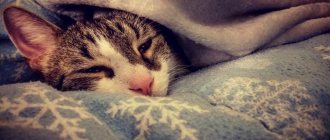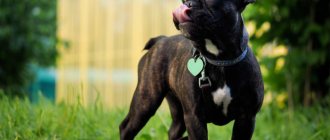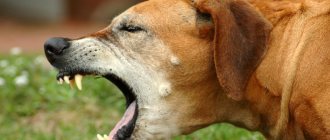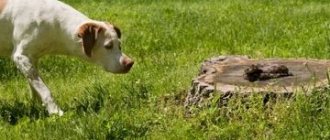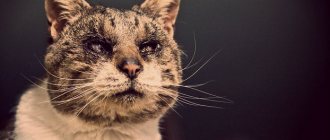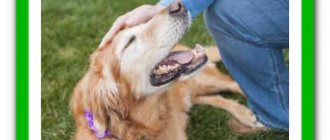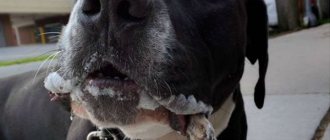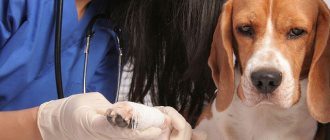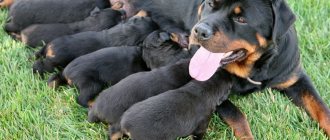Causes and routes of infection
Canine lichen is a disease that affects the fur and skin of an animal. As a rule, the causative agent of the disease is fungi of the genus Microsporum and Trichophyton that get on the skin or hair of the dog. The spores by which they reproduce are able to withstand almost any environmental influences, including temperature fluctuations, maintaining viability for up to 1.5 years.
There are several ways of infection:
- as a result of direct contact of a pet with a sick animal;
- due to fungus getting on the fur from the soil or plants during a walk;
- through combs, bowls, collars and other objects belonging to a sick dog.
Reference! People can bring fungal spores into the house on shoes or clothes.
Homeless animals most often suffer from shingles, but the pathology can also occur in domestic dogs, especially puppies and individuals whose immunity is weakened as a result of pregnancy, the postpartum period and lactation, poor nutrition, previous viral diseases, long-term use of corticosteroids or the presence of malignant tumors.
general information
At the moment, veterinarians do not have a clear opinion, but most of them are inclined to believe that pityriasis rosea is a pathology of an infectious-allergic nature. Presumably caused by the herpes virus. It is very difficult to treat and is dangerous due to constant relapses. All efforts of the owner should be aimed at ensuring long-term remission.
Females are more susceptible to this disease: this is due to moments of increased stress on the immune system during pregnancy and feeding puppies. Also at risk are animals under one year old and over 10 years old. It is believed that pityriasis rosea is inherited due to the inherited immune system.
Of particular concern is the question of whether this pathology can be transmitted to humans. Experts say that people with strong immunity cannot become infected with pityriasis rosea, but if the body’s defenses are impaired, it is better to avoid contact with an infected animal.
The first signs of lichen in a dog
The first 10-14 days after infection are the so-called latent period of the disease, during which the animal does not show any symptoms. After this time, you can already notice the initial signs of pathology, which are expressed in:
- constant itching of the same area;
- apathy;
- sleep disturbance;
- increased excitability;
- blanching of the mucous membranes.
The dog looks lethargic, its taste preferences may change, the lesion gradually increases, and in its place there are broken hairs, changes in skin pigmentation, microcracks and peeling, and partial hair loss.
In addition, all types of lichen, except herpes zoster, are characterized by hyperthermia.
As a rule, signs of skin damage appear on the pet’s paws, face, nose, near the ears, as well as in the lower abdomen and tail.
Reference! Most often, lichen is diagnosed in dachshunds, chihuahuas, pugs, labradors, spitz dogs, Yorkshire terriers, bulldogs and shepherd dogs.
When the first symptoms of the disease are detected, it is necessary to immediately show the animal to a veterinarian, since lichen spreads quickly, and reduced immunity and damage to the skin create a favorable environment for the development of other viral and infectious diseases.
Dog Owner Stories
Valeria: “My shepherd dog developed some kind of black crust on his nose, then the hair in this area began to fall out. The vet diagnosed it as ringworm. We were prescribed Imaverol. They told me to treat the affected area of the nose once every 3-4 days for 2 months. They also prescribed Clotrimazole ointment to smear my nose with. Additionally, they advised to give the dog vitamins. After the first treatment with Imaverol, the dog’s nose turned red and there was ichor in some places. It scared us. But, after 3 days everything began to dry out, and a week later new hairs of fur began to appear on the nose. We managed to completely get rid of lichen in 1.5 months.”
Sergey: “My Yorkie got shingles after the show. We received 2 Microderm injections. One was done immediately at the appointment, the second was done 10 days later. During breaks, I treated the affected areas with Yam ointment. We got rid of this infection quite quickly. During the treatment period, we went with the dog to live in the country so as not to infect the children and the cat.”
Marina: “I always thought that only cats have lichen. Therefore, I didn’t pay much attention when my dog’s hair began to fall out around his eye and redness appeared. The first days I lubricated this area with iodine. It seemed to me that this would be right. But when, after a week, the spot began to increase in size, and the dog began to try to scratch the eye, I got scared. My husband and I took her to the vet. Only there I found out that it was lichen. The doctor immediately prescribed Itraconazole tablets and forbade me to smear the area with iodine. Instead of iodine, he advised treating the wound with Fukortsin. We were treated for almost 2 months. If I had known earlier how dogs get lichen, we would have cured the dog faster.”
Types of lichen in dogs
Depending on the pathogen that caused the pathology, the symptoms that appear and the necessary treatment, several subtypes of the disease are distinguished: pink, weeping, ringworm and pityriasis versicolor.
It is precisely because of the several varieties of the disease that it is important to take the dog to the veterinary clinic immediately after detecting any spots on it that arouse the owner’s suspicion.
In order for treatment to be timely, and for household members to have the opportunity to take measures to prevent the disease, dog owners need to know the symptoms and signs of a particular type of disease.
Pityriasis rosea
Pink or common lichen is an allergic reaction of the dog’s body to a viral infection that affects the digestive tract or respiratory organs, or is provoked by a vaccination. Most veterinarians believe that the development of pathology is due to the genetic predisposition of the animal.
This type of disease is dangerous due to its rapid development and damage to a large area of skin. At the initial stage, an itchy and flaky pink spot with a maximum diameter of 2-3 cm appears on the dog’s skin. After some time, a crust of dry skin forms on it, and similar plaques appear nearby. The main part of the rashes is concentrated in the groin and on the pet's face.
Reference! Complications are possible as a result of fungi, bacteria, and viruses entering the skin.
Pink lichen is characterized by a chronic course, so a complete cure cannot be achieved - the disease will occur constantly with a decrease in immunity caused by stress, a poor diet or frequent illnesses.
Read How to treat diarrhea in a dog at home
This is the only type of lichen that may not require drug treatment - after 1.5-3 months the disease goes away on its own. Despite this, compliance with general recommendations regarding feeding, hygiene and care of a sick animal is mandatory, since this affects its immune system and the speed of recovery.
Ringworm
Lichen moist or weeping eczema is an inflammatory disease that does not occur due to viruses, but as a result of allergies to inappropriate food, lack of hygiene or failure to use antihistamines in a timely manner. As a rule, the pathology occurs in long-haired dogs.
With weeping lichen, swollen areas of skin appear on the lower back, neck, cheeks and at the base of the pet's tail. Over time, they become covered with bubbles that burst and release liquid. The fur in the affected areas falls out, the surface is covered with purulent mucus, under which scabs gradually form. After scraping off the scabs, you may see smooth, shiny skin that is bright red or bluish in color.
Without proper and quick treatment, the lesions quickly spread and cover the entire body of the animal.
Ringworm
The most common type of disease is ringworm or ringworm, caused by Microsporum or Trichophyton fungi.
Symptoms of the disease include the appearance of small round pink or brown spots on the dog’s tail, head, bottom of the paws and behind the ears. Unfortunately, they are often difficult to notice at the initial stage of the disease, especially in long-haired individuals. At the site of the spots, local alopecia, peeling, itching and changes in skin pigmentation are observed. After some time, fluid-filled nodules appear and the skin becomes uneven.
Ringworm spreads quickly, and lack of treatment leads to suppuration beginning under the crusts covering the animal’s body. In addition, at a late stage of the disease, the addition of secondary infectious diseases and even the death of the animal is possible.
Reference! The duration of the incubation period depends on the pet’s immunity; on average, it lasts from 1 to 4 weeks.
This type of lichen can affect not only the dog’s skin and fur, but also its claws, as can be judged by changes in their shape and delamination.
Pityriasis versicolor
The causative agents of pityriasis versicolor or versicolor are yeast fungi that are present on the body of animals and people and do not cause them any harm if they have a strong immune system. Any weakening of the immune system creates favorable conditions for the activation of fungi, which can cause inflammation on the dog’s skin.
Symptoms of pityriasis versicolor manifest themselves in the formation of pinkish, brownish or brownish spots on the skin, which grow and merge in case of untimely treatment or its complete absence.
Reference! Long-haired dogs and animals living in warm places with high humidity are most prone to this pathology.
External therapy
If there is any sign of illness, contact your veterinarian immediately.
It is important not to confuse lichen with other dermatological diseases. It has similar symptoms to dermatitis, folliculitis, eczema, and demodicosis. After diagnosis, the doctor will prescribe treatment. For local treatment, ointment, cream, gel, spray, and shampoo are used. The remedy will have an antifungal, anti-inflammatory, antibacterial result.
The hair from the affected area of skin is cut off. The source of inflammation should be treated several times daily. The resulting crust should soften and be removed. Then the lichen spot is treated with an antiseptic and lubricated with a medicinal agent. Some ointments are toxic and can cause poisoning if your dog licks them. The affected area should be covered with a bandage or bandage. You can put a collar on your dog - a plastic plate. This device is worn around the neck. With it, the dog will not reach the sore spot with its tongue. If the pet takes off the collar, then the animal is dressed in overalls. This way, your pet will not scratch the itchy areas or lick off the ointment, and the skin will not be injured.
Take the Attention Test! Find 10 differences! (click right here!)
Find the answer Are you bothered by some problem or question? Enter “Breed” or “Name of the problem” into the form, press Enter and you will find out everything about the issue that interests you.
Not all types of lichen can be treated with iodine. They can be used to lubricate ringworm. Do not apply to pityriasis rosea and pityriasis versicolor. Iodine can dry out the skin and worsen its condition. It is better to use fucorcin, chlorhexidine or hydrogen peroxide as an antiseptic.
Unadvanced disease is amenable to local therapy. At the first stage of the disease, it is possible to use medicinal ointment without pills or injections. If a bacterial infection occurs, then external agents are used in combination with tablets and injections.
Diagnostics
It is impossible to make the correct diagnosis and prescribe the necessary treatment on your own. This can only be done by a veterinarian, based on the examination of the animal and the results of the tests performed.
In addition, diagnosis is necessary to differentiate lichen from other skin diseases. So, if a pet has a subcutaneous tick, the symptoms at the early stage of the disease are almost identical to lichen, which means that without laboratory tests, the possibility of incorrect therapy cannot be ruled out, which will only harm the animal.
Diagnostic methods:
- Wood's lamp - when illuminated, the affected areas acquire an emerald green color;
- wool analysis (culture) - to determine the type of fungus;
- skin biopsy - to determine the presence or absence of spores and mycelium.
The dog's urine and blood will also need to be tested, and in some cases allergy tests and tests may be required.
How to know if treatment is helping
On average, treatment for lichen in a dog can last up to 6 weeks (if the claws are affected, then up to a year). The prognosis is generally favorable.
- Scabs begin to separate on the affected areas
- New fur begins to grow
- Redness of the skin gradually disappears
- Itching is reduced
The effectiveness of treatment can only be accurately assessed using a Wood's lamp and taking scrapings and cultures from the skin of a sick dog. If in two tests taken at an interval of a month, the fungus that causes lichen is not found, then the dog is considered recovered.
Treatment of lichen in dogs at home
If your dog has shingles, the best option would be to place it in a hospital. However, if for some reason this is not possible, treatment can be carried out at home. The main thing is to strictly follow the veterinarian’s recommendations and use the medications he prescribes. These can be external agents or medications for oral administration.
Read Food allergies in dogs: how they manifest themselves, treatment methods and causes
Medicines for external use
| Drug name | Release form | Description and action | Dosage |
| "Yam Bk" | Ointment | Has a fungicidal-bactericidal effect, effective in combating fungal diseases | Apply a thin layer to affected areas 2-3 times a day for a week |
| "Fungin" | Spray or solution | Eliminates itching, heals wounds, fights pathogenic cells | Apply to affected areas once a day for 2 weeks |
| "Clotrimazole" | Ointment | Prevents the fungus from multiplying, kills it | Apply 3-4 times a day for 3-4 weeks |
| "Sanoderm" | Ointment | Antibacterial, anti-inflammatory and anti-allergenic agent | Apply twice daily for 2-4 weeks |
| Zinc ointment | Ointment | Has drying and antiseptic properties, accelerates healing | Apply 1-2 times a day for a week |
| Ichthyol ointment | Ointment | Has antibacterial, anti-inflammatory and antifungal effects | Apply 1-2 times a day for 7-10 days |
| “Keto Plus”, “Sebozol”, “Nizoral”, “Mycozoral”, “Dermazol” | Shampoo | Promotes the death of fungus | Wash your dog daily for 5-7 days, lathering and leaving the foam on it for 5-10 minutes |
Important! You cannot treat your pet without consulting a veterinarian.
How to apply ointment correctly
Treat the affected area of the skin with an antiseptic, cut off the hair at a distance of 5 mm around it, soak the scabs in a soap solution to soften them, remove the scabs using tweezers, treat the skin with an antiseptic again and remove any remaining moisture with a napkin. Only after this can the ointment be applied.
Iodine for lichen in dogs
The possibility of using iodine for lichen depends on the type of disease and the pathogen that provoked its development. Thus, iodine cannot be used for pityriasis rosea; for the ringworm type of the disease, it has the most noticeable effect; for other types of pathology, the use of iodine does not make sense. You need to lubricate the affected areas with iodine 3-4 times a day, after preparing the skin in the same way as before using the ointment.
Preparations for internal use
If topical anti-lichen medications do not have the desired effect, your veterinarian may prescribe oral medications, most often in tablet form:
- “Ketoconazole” is a potent drug with antifungal, fungistatic and antiandrogenic effects, given with food at a dosage of 5-10 mg/kg every 10-12 hours or 10-20 mg/kg once a day;
- “Fluconazole” – suppresses fungal activity, given with food at a rate of 10-20 mg/kg twice a day;
- “Terbinafine” – has an antimycotic and anti-inflammatory effect, given with food once a day at a dosage of 20-30 mg/kg;
- “Intraconazole” is the most effective for the treatment of ringworm, suppresses the proliferation of the fungus, given with food once a day at a dosage of 10 mg/kg.
Reference! Antibiotics are prescribed only if a secondary infection occurs.
Folk remedies
Among the folk remedies for the treatment of lichen, iodine and apple cider vinegar are most often used.
Iodine should be applied to the affected areas on the pet’s body 3-4 times a day, repeating the procedure until the dog is completely cured.
The use of vinegar differs only in the frequency of treatment of affected areas - this should be done 5-6 times a day.
Reference! This method is only relevant for pityriasis rosea.
All non-drug remedies can only cope with the symptoms of the pathology - swelling, irritation, redness; they cannot get rid of the fungus itself.
How to prevent licking ointment and scratching
Almost all types of lichen are characterized by severe itching. Due to constant scratching of the affected areas, the infection spreads to healthy tissue, which aggravates the course of the disease and slows down the healing process. The same thing happens when a dog licks the ointment.
If there are not many lesions, you can bandage or seal them, after lubricating the skin with ointment. If the affected area is large, you can prevent scratching or licking the medicine by putting a special collar on the dog.
Some animals are categorically against the collar and try in every possible way to remove it. In such a situation, you need to put a jumpsuit on your pet.
How to care for a sick dog
First of all, it is necessary to scrupulously follow all the veterinarian’s instructions, regularly take tests and monitor them. so that the pet receives proper and balanced nutrition. Also important:
- maintain personal hygiene – yours and that of the animal;
- walk the dog, pet it and care for it only with gloves;
- clean the premises daily, preferably using disinfectants;
- Replace your pet's bedding and wash a new one every day.
Read Blood tests for dogs: types and interpretation of indicators
In addition, all objects that the dog has come into contact with should be disinfected daily.
Feeding during treatment
During the treatment of lichen, especially pink and weeping, it is necessary to change the dog's diet. A special diet helps to minimize the toxicity and allergenicity of certain foods and substances.
It is necessary to exclude from the pet's diet:
- potato;
- chocolate and other sweets;
- smoked meats, spices, all types of spices;
- products that contain dyes, flavors, preservatives and other chemical additives.
If you have weeping lichen, it is also forbidden to feed your dog meat and meat products.
Use of folk remedies
It is possible to treat lichen with folk remedies only at the initial stage of the disease, when there is a single number of lesions on the skin. More often than not, folk remedies are combined with treatment prescribed at a veterinary clinic.
- Garlic is often used to treat ringworm. Cut a clove of garlic in half and rub the affected area. The procedure is repeated 3-4 times a day until recovery.
- Wipe the dog's bald spots with apple cider vinegar, and then apply garlic juice, previously diluted 1:1 with camphor oil. Treatments are carried out 3-4 times a day.
- Garlic juice is mixed with a small amount of honey and the resulting mixture is used to treat skin spots 3-5 times a day.
- The head of garlic is peeled and passed through a garlic press. Add approximately the same amount of apple cider vinegar and leave to brew for 2 days. Treatment is carried out 3-5 times a day until the skin is completely cleansed.
- Pharmaceutical tar has a quick effect in the treatment of lichen. A piece of cotton wool is wound on a wooden stick, moistened in tar and generously lubricated on the areas of skin affected by lichen. The procedure is carried out 3 times a day. Usually on the 3-4th day, the crusts on the bald patches disappear. A 30 ml bottle in pharmacies costs about 35 rubles.
- You can also take medicinal baths with celandine. 300 g of herb is poured with cold water and brought to a boil. The solution is removed from the heat and left to infuse for an hour. The strained infusion is poured into a container of warm water where the dog will be bathed. Bathing should take no more than 10 minutes, every other day. Celandine herb is sold in pharmacies; one 50g box costs 60 rubles.
Prevention
To prevent the occurrence of pathology, you must follow a few simple recommendations:
- exclude contact of the dog with sick and homeless animals;
- provide your pet with proper, balanced nutrition, include vitamins and minerals in the diet;
- follow the vaccination schedule;
- treat all pathologies in a timely manner, preventing a decrease in immunity;
- regularly clean the apartment and bathe the pet;
- Avoid using bowls, collars and other items that belong to other dogs.
It is also important to provide your pet with regular walks and the required level of physical activity - this helps strengthen the animal’s immunity.
Vaccination against lichen
Unfortunately, there is no vaccine that would guarantee complete protection against all types of lichen. However, Vakderm has proven itself quite well in comparison with other drugs. This is an intramuscular injection containing inactive dermatophyte fungi, which provoke the development of fungal infections of the skin. The injection can be given to both a healthy dog to prevent the disease and an already infected animal.
The vaccination course involves two doses of the drug with an interval of 10-14 days. If the pet is absolutely healthy at the time of the procedure, there will be no side effects. If an animal infected with lichen is vaccinated, external signs of pathology may appear in places where the infection accumulates, but after revaccination the pet will be healthy.
A dog can be vaccinated only after it has been examined, examined and dewormed.
Important! After vaccination, it is mandatory to take immunomodulators, hepatoprotectors and vitamins.
Vaccinations against lichen
There are a number of vaccinations against lichen and they are inexpensive. In addition to being therapeutic vaccines, the immune response lasts in the animal for at least a year. The cost of such drugs is relatively low and they are easy to find. Here are some examples:
- Vakderm Russia is aimed against trichophytosis and microsporia. Immunity lasts at least 1 year.
- Polivak-TM from Narvak, Russia. Active against microsporia and trichophytosis and maintains an immune response for up to 12 months.
- Microderm, Russia, has the same properties.
What is typical is that all vaccines are safe and do not cause harm in case of an error in diagnosis!
Can humans or pets become infected?
Humans and pets do not have immunity to this disease, which means they can also become infected with lichen from a dog. To understand whether there is a risk, it is important to determine the type of disease. So, ringworm is definitely contagious, but the pityriasis and oozing types of pathology do not pose a danger. The risk of contracting pityriasis rosea is questionable, but it is believed that with a strong immune system there is nothing to worry about.
The disease is transmitted to humans as a result of direct contact with the animal, therefore, for safety reasons, the pet should be isolated by moving it to a separate room, which will later need to be cleaned using chemicals, and all care for it should be carried out only with gloves.
There is no need to be afraid of this disease. Long gone are the days when dogs with lichen were euthanized because the pathology was considered incurable. Today, there are many effective drugs that help fight the disease. The main thing is to contact a veterinarian in time, and then carefully follow all his recommendations.
Types of disease
The danger of pityriasis rosea is that it develops rapidly, affecting a large area of skin.
At the beginning of the disease, one plaque forms, which branches out over time, covering increasingly large surfaces of the pet’s skin with small pink spots. The lesions of pityriasis rosea are round in shape, with a diameter of about 2 cm.
A characteristic manifestation of pityriasis rosea for an animal is unbearable itching.
Shearer
The second heaviest is the shearer. The peculiarity of this species is that it affects the scalp and body. Its targets will be: paws, nose, tail, and in exceptional cases, it affects the pet’s nail plates.
Ringworm can be recognized by lesions that have a characteristic creamy color. The lesions have a round, slightly oval shape.
The affected areas peel off and gradually lose all vegetation. The hairs of the wool have a specific, clipped appearance, which is why it received its name.
Pink lichen and ringworm are contagious. The remaining species are not so dangerous to the environment and the life of the animal, but they cannot be ignored.
Weeping
Ringworm is common.
The disease is not contagious, but it can cause quite a lot of trouble for both the pet and the owner. It is a consequence of an allergy. Now we list the main symptoms:
- Swelling of the skin
- Minor rashes
- Itching and burning
- The appearance of small cracks in the skin
- Formation of small bubbles.
Pityriasis
One of the “exotic” species is pityriasis versicolor.
What’s noteworthy is that, according to statistics, dog lovers more often turn to veterinarians for it. The disease begins with a small, barely noticeable pinkish spot that appears on the dog’s body or head. The lesions develop without severe inflammation and gradually, in a pointwise manner, appear on different parts of the pet’s skin. The lesions have a yellowish-brown color.
girdling
The last type that will be discussed in this post is shingles.
It develops as a result of a pet being infected with herpes. It affects areas between the ribs and the abdomen.
